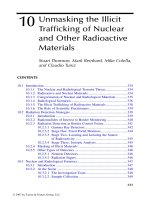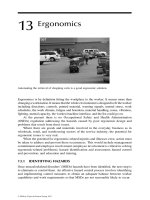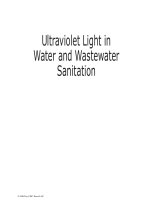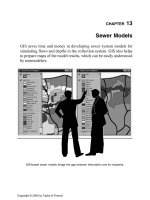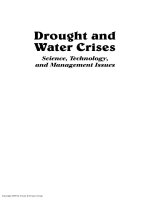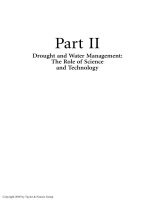Drought and Water Cruises: Science, Technology, and Management Issues - Chapter 13 pptx
Bạn đang xem bản rút gọn của tài liệu. Xem và tải ngay bản đầy đủ của tài liệu tại đây (735.47 KB, 21 trang )
345
13
A Role for Streamflow Forecasting
in Managing Risk Associated with
Drought and Other Water Crises
SUSAN CUDDY, REBECCA LETCHER, FRANCIS H. S.
CHIEW, BLAIR E. NANCARROW, AND TONY JAKEMAN
CONTENTS
I. Introduction 346
A. Seasonal Forecast and Climate Variability 346
B. Adoption Constraints 347
II. Estimating the Potential 348
A. Case Study Context 348
B. Seasonal Forecast Models 350
C. Forecast Model Results 353
D. Decision-Making Models 355
E. Modeling Results 356
III. Reality Bites 359
IV. Summary 362
V. Future Directions 363
Acknowledgments 364
References 364
DK2949_book.fm Page 345 Friday, February 11, 2005 11:25 AM
Copyright 2005 by Taylor & Francis Group
346 Cuddy et al.
I. INTRODUCTION
Climatic variability should be a significant factor influencing
agricultural production decisions. Historically in Australia,
farmers and governments have invested heavily in reducing
the influence of this variability on agricultural production.
This investment has included construction of large dams on
major river systems throughout the country, primarily for
irrigation purposes, and allocation and development of
groundwater resources. This development policy placed large
pressures on ecosystems and has significantly modified river
systems. In 1994, the Council of Australian Governments
began a period of water reform, entering a new management
phase for water resources. These reforms have included
assessment of the sustainable yield from aquifer systems,
often found to be below current allocation and even extraction
levels, as well as allocation of a proportion of flows to the
environment. In many catchments these water reforms have
not only reduced irrigators’ access to some types of water but
have also implicitly increased the effect of climate variability
on their decision making by increasing their reliance on
pumping variable river flows.
These management and allocation pressures are com-
pounded by Australian streamflow (and to a lesser extent
climate) being much more variable than elsewhere in the
world. The interannual variability of river flows in temperate
Australia (and southern Africa) is about twice that of river
flows elsewhere in the world (Figure 1; Peel et al., 2001). This
means that temperate Australia is more vulnerable than
other countries to river flow–related droughts and floods. In
such a challenging environment, forecasting tools that sup-
port improved decision making resulting in efficiencies in
water use and reduced risk taking are highly desirable. The
development and use of such tools is the focus of considerable
research and extension activity in government and industry.
A. Seasonal Forecast and Climate Variability
Relationships between sea surface temperatures and climate
are well documented. The relationship between Australia’s
hydroclimate and the El Niño/Southern Oscillation (ENSO)
DK2949_book.fm Page 346 Friday, February 11, 2005 11:25 AM
Copyright 2005 by Taylor & Francis Group
A Role for Streamflow Forecasting 347
is among the strongest in the world (Chiew and McMahon,
2002). El Niño describes the warm phase of a naturally occur-
ring sea surface temperature oscillation in the tropical Pacific
Ocean. Southern oscillation refers to a seesaw shift in surface
air pressure at Darwin, Australia, and the South Pacific island
of Tahiti. Several indices have been derived from this rela-
tionship, in particular the Southern Oscillation Index (SOI),
which describes the Tahiti minus Darwin sea level pressure
and is commonly used as an indicator of ENSO. The strong
relationships that exist between climate, streamflow, and
ENSO form the scientific basis for forecast tools developed
throughout Australia and other parts of the world. In the
Australian context, the Bureau of Meteorology routinely pro-
vides seasonal climate outlooks (e.g., probability that the total
rainfall over the next 3 months will exceed the median) and
computer packages such as
Rainman Streamflow
(Clewett et
al., 2003) are heavily promoted. The patchy adoption of these
tools, and thus the inability to reap the perceived gains in
water use efficiency, is of concern to their promoters and
research and development agencies.
B. Adoption Constraints
A major issue for the designers of decision support tools is
the degree of likely uptake by the potential users, and this is
no different for seasonal forecasting. The farming community,
Figure 1
Interannual variability of Australian streamflow rela-
tive to the rest of the world.
The L-Cv is used as a measure of inter-
annual runoff variability.
It is a measure of relative variability
similar to the coefficient of variation
(standard deviation divided by the mean).
The L-Cv in the plot are for catchments in
the Cfb Koppen climate type, which
represents a temperate climate.
0
0.1
0.2
0.3
0.4
0.5
0.6
10 100 1000 10000
Mean annual runoff (mm)
L-Cv of annual runoff
Australia
World
DK2949_book.fm Page 347 Friday, February 11, 2005 11:25 AM
Copyright 2005 by Taylor & Francis Group
348 Cuddy et al.
which is traditionally conservative when it comes to changing
well-entrenched behaviors, is particularly reticent to adopt
such tools. Many factors play a part in users’ decisions to
adopt these tools and the information they provide.
Knowledge, awareness, and understanding of the poten-
tial outcomes available through the use of the tools vary.
Confidence in the outcomes is often lacking, especially when
the tools may be replacing well-tried and comfortable prac-
tices. These practices may be seen to be adequate for the
decisions they are assisting, and hence users do not perceive
a need for new technologies.
Previous experiences associated with the technologies
being used by the tools will also be a factor. These may be
first-hand experiences or purely word of mouth in the com-
munity. Local opinion will frequently be more powerful than
information from “outsiders.” Naturally, if past experiences
have resulted in negative consequences, the uptake of the new
technology will be even less likely. Confidence in the new
technology and trust in the provider of the technology are
therefore likely to be highly influential. In fact, the “human
factor” frequently can be less certain than the technologies
themselves.
II. ESTIMATING THE POTENTIAL
Most investigations of the potential of forecast tools compare
their predictions against “no knowledge.” This section
describes the coupling of forecast models to models that sim-
ulate a range of water management behaviors within a con-
strained problem definition. Quantification of the net
financial return to irrigators of adopting climate forecasts as
part of their decision-making process would provide a strong
measure of the benefit of these forecasts. This is tempered by
an analysis of the potential market, which reveals that a
significant improvement in reliability and relevance is
required before widespread adoption can be considered.
A. Case Study Context
To consider the potential benefits to agricultural production
of seasonal forecasts, we investigated their potential impact
DK2949_book.fm Page 348 Friday, February 11, 2005 11:25 AM
Copyright 2005 by Taylor & Francis Group
A Role for Streamflow Forecasting 349
on farm-level decisions and returns in an irrigated cropping
system. We premised that the potential benefit of seasonal
forecasts was probably greatest in a farming system subject
to significant uncertainty. For this reason, the farming system
represented in the decision-making models is that of an irri-
gated cotton producer operating on an unregulated river sys-
tem, relying on pumping variable river flows for irrigation
purposes during the season. This type of farm is typical in
unregulated areas of the Namoi basin in the northern Mur-
ray-Darling basin, particularly the Cox’s Creek area (Figure
2). However, for this analysis, the modeling should be consid-
ered to represent a theoretical or model farm rather than a
farm from a particular system; the value of forecasts was
tested on this farm using forecasts and flows from many
Figure 2
Map of the case study area highlighting the Cox’s Creek
region of the Namoi basin within the Murray-Darling basin system
of eastern Australia.
Namoi Basin
Coxs Creek
418025
412080
421636
412082
410033
410061
410047
Murray-Darling Basin
DK2949_book.fm Page 349 Friday, February 11, 2005 11:25 AM
Copyright 2005 by Taylor & Francis Group
350 Cuddy et al.
different river systems in eastern New South Wales. We did
this to test the sensitivity of the results and recommendations
to the hydrology and climate of the river system.
Given that the model farm is assumed to be pumping
from the river for irrigation supply, production and water
availability are limited by the number of days on which the
farm can pump flows from the river. To mimic the types of
flow rules on these unregulated systems and to test the sen-
sitivity of results to these rules, two pumping thresholds were
considered—the 20th and 50th percentile of flow (i.e., flow
that is exceeded 20% or 50% of the time).
The forecast provided for each year is the number of days
that are above these pumping thresholds (i.e., the number of
days on which pumping is allowed). The model farmer factors
this forecast and the total volume of water allowed to be
pumped on each such day (the daily extraction limit, defined
by policy as a fixed volume of water) into the planting decision.
Climate forecasts were constructed over an 86-year
period for seven catchments and the two pumping threshold
regimes using three forecast methods. Farmer decisions were
then simulated using these three forecast methods as the
basis of the decision, as well as using three decision alterna-
tives for comparison. This section describes the catchments
considered in the analysis and the climate forecasting results
for each. The decision models used in the analysis of these
forecasts are then described before results are presented.
These results should be considered to be indicative of the
potential benefits of seasonal forecasting in eastern Australia.
The complexity of different production systems and many of
the influences on real-life decisions have not been considered
for this preliminary analysis. However, this analysis does
provide an interesting insight into the potential for forecast-
ing methods to help farmers adjust away from the impacts of
climate variability.
B. Seasonal Forecast Models
The relationship between streamflow and ENSO and the
serial correlation in streamflow can be exploited to forecast
streamflow several months ahead. These relationships are
DK2949_book.fm Page 350 Friday, February 11, 2005 11:25 AM
Copyright 2005 by Taylor & Francis Group
A Role for Streamflow Forecasting 351
well described in Chiew and McMahon (2003) and demon-
strate the statistical significance of the lag correlation of the
linear relationship between 3-month streamflow (in
Oct–Nov–Dec and in Jan–Feb–Mar) and the SOI value in the
previous 3 months in catchments throughout Australia. Using
this relationship, we can forecast summer streamflow
throughout most of eastern Australia from spring indicators
of ENSO. Serial correlation in streamflow must also be con-
sidered when forecasting streamflow because it is generally
stronger than the streamflow–ENSO relationship and is per-
sistent throughout the year.
To make risk-based management decisions, we must
express forecasts as exceedance probabilities (e.g., probability
of getting at least 10 pumping days). In this study, exceedance
probability forecasts are derived at tributary scale for seven
unimpaired catchments in the Murray-Darling basin. The
derivation of the forecasts is based on categorization and
consequent nonparametric modeling of streamflow distribu-
tions and their antecedent conditions (e.g., discrete SOI cat-
egories) (see, for example, Sharma, 2000, and Piechota et al.,
2001). Catchments were selected because of their relative
proximity to the Namoi basin (all within the Murray-Darling
basin in New South Wales) and to reflect a range of rain-
fall–runoff conditions and forecast skills. Proximity to the
Namoi basin is to support coupling with the decision-making
models that have been developed by Letcher (2002) within
the water management regulatory framework in the Namoi
basin, although they simulate representative farmer behavior.
Daily streamflow data from the period 1912–1997 are
used. The data include extended streamflow estimates using
a conceptual daily rainfall–runoff model (Chiew et al., 2002).
The catchment locations and long-term average rainfall–run-
off characteristics are summarized in Table 1.
Forecasts are made for the number of days in Octo-
ber–February that the daily flow exceeds the two pumping
thresholds under consideration. The thresholds are calculated
based on flow days only, defined as days when the daily flow
exceeds 0.1 mm. The forecast is derived by relating the num-
ber of days in October–February that the daily flow exceeds
a threshold to explanatory variables available at the end of
DK2949_book.fm Page 351 Friday, February 11, 2005 11:25 AM
Copyright 2005 by Taylor & Francis Group
352 Cuddy et al.
T
ABLE
1
Summary of Characteristics for Catchments Used in the Analysis
Catchment
Catchment and Rainfall–Runoff Characteristics
Lat. Long.
Area
(km
2
)
Rainfall
(mm)
Runoff
(mm)
Runoff
Coef.
(%)
% Days
Flow
>0.1 mm
Percentile
Flows (mm)
20% 50%
410033 Murrumbidgee R @
Mittagang Crossing
36.17 149.09 1891 882 134 10–15 71
0.55 0.28
410047 Tarcutta Ck @ Old
Borambola
35.15 147.66 1660 818 110 10–15
50 0.68 0.31
410061 Adelong Ck @ Batlow
Road
35.33 148.07 155 1138 256 >20
89 0.97 0.44
412080 Flyers Creek @ Beneree 33.50 149.04 98
915 106 10–15 50 0.65 0.29
412082 Phils Creek @ Fullerton 34.23 149.55 106
821 124 10–15 62 0.58 0.27
418025 Halls Creek @ Bingara 29.91 150.58
156 755 44 6 24 0.22 0.14
421036 Duckmaloi River @
Below Dam Site
33.77 149.94 112 967 244 >20
80 0.95 0.40
DK2949_book.fm Page 352 Friday, February 11, 2005 11:25 AM
Copyright 2005 by Taylor & Francis Group
A Role for Streamflow Forecasting 353
September. The explanatory variables used are the SOI value
averaged over August and September and the total flow vol-
ume in August and September. We derive the forecast using
the nonparametric seasonal forecast model described in
Piechota et al. (2001) and express it as exceedance probabil-
ities. Such forecasts closely approximate low-risk decision-
making behavior and can be used as a direct input into the
decision-making models.
Three forecast models are used:
1. FLOW: Forecast derived from flow volume in
August–September
2. SOI: Forecast derived from SOI value in August–Sep-
tember
3. FLOW+SOI: Forecast derived from flow volume and
SOI value in August–September
C. Forecast Model Results
All models exhibit significant skill in the forecast, summa-
rized in Table 2.
Two measures of forecast skill are
used—Nash-Sutcliffe E and LEPS scores.
The Nash-Sutcliffe E (Nash and Sutcliffe, 1970) provides
a measure of the agreement between the “mean” forecast
(close to the 50% exceedance probability forecast) and the
actual number of days in October–February that the daily
flow exceeds a threshold. A higher E value indicates a better
agreement between the forecast and actual values, with an E
value of 1.0 indicating that all the “mean” forecasts for all
years are exactly the same as actual values.
The LEPS score (Piechota et al., 2001) attempts to com-
pare the distribution of forecast (forecast for various exceed-
ance probabilities) with the number of days in
October–February that the daily flow exceeds a threshold. A
LEPS score of 10% generally indicates that the forecast skill
is statistically significant. A forecast based solely on climatol-
ogy (same forecast for every year based on the historical data)
has a LEPS score of 0.
DK2949_book.fm Page 353 Friday, February 11, 2005 11:25 AM
Copyright 2005 by Taylor & Francis Group
354 Cuddy et al.
T
ABLE
2
Summary of Forecast Skills for Catchments Used in the Analysis
Catchment
Forecast Skill
Case
FLOW
SOI
FLOW+SOI
E LEPS E LEPS E LEPS
410033 Murrumbidgee R @ Mittagang Crossing Days >20%
0.35 27.1 0.23 11.6 0.58 41.7
Days >50% 0.36 23.1 0.19 12.2 0.60 39.7
410047 Tarcutta Ck @ Old Borambola
Days >20% 0.41 32.8 0.23 17.6 0.57
46.4
Days >50 0.39 26.2 0.18 11.2 0.50
36.0
410061 Adelong Ck @ Batlow Road
Days >10% 0.54 41.4 0.16 12.0 0.64 49.5
Days >20% 0.63 42.0 0.17 11.1 0.71
50.4
412080 Flyers Creek @ Beneree
Days >20% 0.34 25.8 0.22 10.2 0.54
37.6
Days >50% 0.42 28.8 0.22 10.9 0.56 40.0
412082 Phils Creek @ Fullerton
Days >20% 0.40 19.2 0.22 12.3 0.59 32.1
Days >50% 0.54 30.0 0.22 12.2 0.64
39.7
418025 Halls Creek @ Bingara
Days >20% 0.13 12.4 0.16 11.7 0.29 26.3
Days >50% 0.26 15.3 0.16 13.0 0.44 31.5
421036 Duckmaloi River @ Below Dam Site Da
ys >20% 0.16 12.3 0.24 13.5 0.45 28.1
Days >50% 0.24 16.7 0.27 17.7 0.51 34.0
DK2949_book.fm Page 354 Friday, February 11, 2005 11:25 AM
Copyright 2005 by Taylor & Francis Group
A Role for Streamflow Forecasting 355
The LEPS scores in all the forecast models are greater
than 10%, indicating significant skill in the forecast. The SOI
model has similar skill in the seven catchments, with E values
of about 0.2 and LEPS scores of 10–15%. The FLOW model
is considerably better than the SOI model in five catchments
(410033, 410047, 410061, 412080, 412082; E generally greater
than 0.35 and LEPS generally greater than 25%), whereas at
the gauge sites of the other two catchments (418025, 421036),
the FLOW and SOI models have similar skill. In all seven
catchments, the FLOW+SOI model has greater skill than the
FLOW or SOI model alone. In the five catchments where the
FLOW model has greater skill than the SOI model, the E and
LEPS for the FLOW+SOI model are generally greater than
0.5 and 40%, respectively (compared to 0.35 and 25% in the
FLOW model). In the two catchments where the FLOW model
and SOI model have similar skill, the E and LEPS for the
FLOW+SOI model are generally greater than 0.3 and 25%
(compared to less than 0.25 and 20% in the FLOW or SOI
model alone).
D. Decision-Making Models
All decisions were modeled using a simple farm model that
assumed that farmers act to maximize gross margin each
year, given constraints on land and water available to them
in the year. This model is a modified version of a decision
model for the Cox’s Creek catchment developed by Letcher
(2002). Total farm gross margin was analyzed for all catch-
ments, pumping thresholds, and forecast methods using four
possible decision methods:
1.
Seasonal forecast decision
. The decision is made
assuming that the 20th and 50th percentile exceed-
ance probability forecasts (using SOI, FLOW, and
SOI+FLOW) for the number of pumping days are
correct.
2.
Naïve decision
. The decision is made assuming that
the number of pumping days this year is equal to the
number of pumping days observed last year.
DK2949_book.fm Page 355 Friday, February 11, 2005 11:25 AM
Copyright 2005 by Taylor & Francis Group
356 Cuddy et al.
3.
Average climate decision
. The decision is made
assuming that the number of days for which pumping
is possible in each year is the same and equal to the
average number of days pumping is permitted over
the entire 86-year period.
4.
Perfect knowledge decision
. The decision is made with
full knowledge of the actual number of days on which
pumping is possible in each year. This is essentially
used to standardize the results, because it is a mea-
sure of the greatest gross margin possible in each
year given resource constraints.
The same simple farm model is used in all cases. This
model allows the farm to choose among three cropping
regimes—irrigated cotton with winter wheat rotation, dry-
land sorghum and winter wheat rotation, and dryland cotton
and winter wheat rotation. Production costs are incurred on
crop planting, so areas planted for which insufficient water
is available over the year generate a loss. For such crops, it
is assumed that the area irrigated is cut back and a dryland
yield is achieved on the remaining area planted.
E. Modeling Results
We ran models for each catchment over the 86-year period for
every combination of pumping threshold, forecast, and deci-
sion-making method. The total gross margin achieved by the
farm over the entire simulation period under each of the
decision models and forecasting methods is charted for the
20th percentile (Figure 3) and the 50th percentile (Figure 4)
pumping threshold, respectively.
In each figure, the x axis
labels the seven catchment identifiers and the y axis is the
total gross margin in Australian dollars.
These figures lead to a consistent set of observations:
• Use of any of the three forecast methods leads to a
greater gross margin than either the average or the
naïve decision methods.
• In general, the SOI+FLOW method gives the greatest
gross margin of the three forecast methods, with SOI
generally providing the lowest gross margin.
DK2949_book.fm Page 356 Friday, February 11, 2005 11:25 AM
Copyright 2005 by Taylor & Francis Group
A Role for Streamflow Forecasting 357
Figure 3
Total profit (annual gross margin) over 86-year simula-
tion period for each catchment using different decision methods for
pump threshold at the 20th percentile of flow.
Figure 4
Total profit (annual gross margin) over 86-year simula-
tion period for each catchment using different decision methods for
pump threshold at the 50th percentile of flow.
$10,000,000
$12,000,000
$14,000,000
$16,000,000
$18,000,000
$20,000,000
$22,000,000
410033 410047 410061 412080412082418025 421036
FLOW
SOI
SOI+FLOW
Average
Naïve
PERFECT
$10,000,000
$15,000,000
$20,000,000
$25,000,000
$30,000,000
$35,000,000
410033 410047 410061 412080 412082418025 421036
FLOW
SOI
SOI+FLOW
Average
Naïve
PERFECT
DK2949_book.fm Page 357 Friday, February 11, 2005 11:25 AM
Copyright 2005 by Taylor & Francis Group
358 Cuddy et al.
• The forecast methods provide a substantial return in
gross margin relative to the total achievable gross mar-
gin (via the perfect decision model) in each case (on
average, 55% of the possible maximum).
To investigate the consistency of the forecast skill, we
derived the percent of time during the simulation period dur-
ing which different income levels were exceeded for each deci-
sion model and forecast method. Results for a single
catchment (410033) and the 20th percentile pumping thresh-
old are presented in Figure 5.
Several observations can be made about the consistency
of the forecasts:
• Negative gross margins (losses) are experienced in a
greater number of years for both the average and naïve
decision methods (>7% of time) than for any of the
seasonal forecast methods (<3.5%).
Figure 5
Exceedance probability for annual gross margin for one
catchment (410033) with a pumping threshold at the 20th percentile
of flow.
-$200,000
-$100,000
$0
$100,000
$200,000
$300,000
$400,000
$500,000
$600,000
$700,000
$800,000
0% 20% 40% 60%80% 100% 120%
Time Exceeded
Annual Gross Margin
Average
Naïve
FLOW
SOI
SOI+FLO
W
Perfect
DK2949_book.fm Page 358 Friday, February 11, 2005 11:25 AM
Copyright 2005 by Taylor & Francis Group
A Role for Streamflow Forecasting 359
• The naïve and average decision methods give a lower
income at almost all exceedance probabilities, and for
those areas where they are greater, the difference is
very small.
• The naïve decision method gives a greater gross mar-
gin for very high gross margin years (2.4% of the time).
III. REALITY BITES
The integrated modeling approach developed for this study
demonstrates the gains that can be made by the routine
incorporation of seasonal forecasting into water management
decision.
To test the likeliness of farmers to use the seasonal fore-
casting tools, we conducted a series of ten semistructured,
scoping interviews. The interviewees were irrigators on a non-
regulated tributary of the Namoi River (in the Upper Murray-
Darling basin) and were therefore highly dependent on the
river flows. With the uncertainty of annual water supplies to
irrigate their crops, it was thought that this group might be
more positive about seasonal forecasting than those on regu-
lated rivers.
Given the small sample number, we compared the data
collected with that from a similar study conducted by others
in the southern Murray-Darling basin (URS Australia, 2001).
That study consisted of 29 interviews followed by a workshop
with six participants. The findings of both studies were sim-
ilar, thus providing confidence in the outcomes of these limited
interviews.
Knowledge and understanding of the term and the forms
of seasonal forecasting were highly variable, ranging from a
good understanding to little or misguided awareness. Partic-
ipants seemed to misunderstand the difference between types
of forecasting and sources of forecasting. However, consider-
able support exists for natural signals rather than the use of
technology—for example:
Some of the best indicators in times of drought have been
the ants’ nests around the house—if there is a lot of
movement by the ants, it’s generally going to rain soon.
DK2949_book.fm Page 359 Friday, February 11, 2005 11:25 AM
Copyright 2005 by Taylor & Francis Group
360 Cuddy et al.
There are many natural signs that are more useful than
the scientific information we are given.
The degree to which people understood probabilities, or
thought they could be useful to them, was also variable. Many
were skeptical of the probabilities given their derivation by
the extrapolation of past data to the present. Usefulness was
also questioned in view of past experiences:
At the last meeting we were told, “There will be a 50/50
chance that we will get above-average rainfall and 50/50
chance we will get below-average rainfall.” This told us
nothing.
The degree to which these farmers incorporated seasonal
forecasting information into their decision making was also
variable. Although no one used it as a regular aid, some said
they sometimes used it, others considered it but rarely used
it, and some said they did not use it at all.
Those who said they did use it indicated that it could
affect changes in planning for the timing of seeding, spraying
times, planting rates, the type of crops planted, and the num-
ber of stock purchased. However, they stressed that the sea-
sonal forecasting was only one piece of information they used,
combining it with natural indicators and sources of informa-
tion used in the past. Decisions were still very conservative.
If they say it is going to be a dry year I won’t buy more
cattle. If it is going to be a wet year, I may decide to buy
more cattle.
Those who did not use seasonal forecasting in their deci-
sion making were reluctant to do so because they had bad
experiences in the past, or had heard of someone who had.
Other reasons included a lack of understanding or restricted
access to the information. They seemed to pay more attention
to short-term forecasting than to seasonal. The consequences
of poor short-term decisions were not seen to be as dire as
the consequences of seasonal mistakes.
Really if your gut feeling tells you it is going to be dry
then it probably will be. If it tells you it will be wet, it
probably will be.
DK2949_book.fm Page 360 Friday, February 11, 2005 11:25 AM
Copyright 2005 by Taylor & Francis Group
A Role for Streamflow Forecasting 361
I’m an old-time farmer and I feel that you take what you
get.
I don’t have much confidence in the information. It is
usually only 50% accurate which is the same as tossing
a coin.
Rainfall probabilities were considered to be the most
useful information seasonal forecasting could provide. How-
ever, decision making would still be highly conservative.
I would pay attention if they told me there was a 75%
chance that we will go into a drought. However, if they
told me that there was a 25% chance of below-average
rainfall, with a 75% chance of above-average rainfall, I
would pay more attention to the prediction of below-aver-
age rainfall.
The farmers were asked if they would be more willing to
use a tool that predicted only extreme events with better than
usual reliability, rather than more frequent rainfall predic-
tions with lesser certainty. Generally it was agreed that this
would be preferable, but there was considerable cynicism that
sufficient reliability could be obtained for their purposes.
They did acknowledge, however, the difficulty associated
with forecasting, especially given the limited recorded
weather history in Australia. Then again, it seemed there was
little likelihood that any latitude would be given to the sci-
entists if the forecasts were mistaken. Reliability was very
important, and until this could be achieved to help farmers
in decision making, uptake of the technology would be limited.
And memories can be very long.
Indigo Jones was a long-range forecaster a while back,
and he was considered to be very good. In 1974 he pre-
dicted it would be wet and we had some of the biggest
floods in history. However, in 1975 he predicted it would
be wetter still, and we had one of the worst droughts on
record. After that I lost faith in long-range forecasters.
It is therefore apparent that the potential market for
seasonal forecasting tools in the farming community will be
limited in the short term. One must understand the likely
DK2949_book.fm Page 361 Friday, February 11, 2005 11:25 AM
Copyright 2005 by Taylor & Francis Group
362 Cuddy et al.
users of the technology and exactly what decisions they
believe it can assist them with.
IV. SUMMARY
Regions with high interannual variability of streamflow
present challenges for managing the risks associated with the
use of their water resource systems. Reliable forecasts of
streamflow months in advance offer opportunities to manage
this risk. Knowledge of more or less streamflow than average
has the potential to influence farmer decision making and/or
the allocation of water to the environment or to replace
groundwater stocks under threat. In the long term, it has the
potential to improve the viability of agricultural production
activities and increase water use efficiency while maintaining
desirable environmental flows.
The ability of the integrated modeling approach
described above to provide comparison with alternate heuris-
tic forecasting techniques has demonstrated the practical
advantage of forecasting methods over these alternate tech-
niques. In the overwhelming number of cases, where water
management and consequent planting decisions were based
on seasonal forecasts, the enterprise would have returned a
better result in terms of water use efficiency and net gains in
profit. Yet adoption is slow, perhaps reflecting the general
conservative nature of farmers, at least in Australia, and the
need for them to see real and sustained benefit before they
will consider incorporating such tools into their decision mak-
ing.
The social analysis confirmed that knowledge and under-
standing of the term and the forms of seasonal forecasting
were highly variable. There seemed to be a misunderstanding
of the difference between types of forecasting and sources of
forecasting. However, there was considerable support for nat-
ural signals rather than the use of technology. The degree to
which people understood probabilities, or thought they could
be useful, was also variable. Many were skeptical of the prob-
abilities given their derivation by the extrapolation of past
data to the present. Their usefulness was also questioned in
view of past experiences.
DK2949_book.fm Page 362 Friday, February 11, 2005 11:25 AM
Copyright 2005 by Taylor & Francis Group
A Role for Streamflow Forecasting 363
An aggressive water reform agenda, underpinned by an
acknowledgment of the finite size of the water resource and
recognition of the legitimacy of the environment as a water
user, is driving research in and development of tools that can
fine-tune critical decisions about water allocation.
V. FUTURE DIRECTIONS
In spite of recent improvements, adoption of climate variabil-
ity management tools such as seasonal forecasting is low
among the farming community. Farmers have expressed neg-
ativity about the reliability of the tools and their benefits.
It could be argued that many farmers, particularly those
in large irrigated enterprises, have already reduced the risk
associated with timely access to water by building large on-
farm water storages and installing more efficient water retic-
ulation systems—that is, they have invested (at a significant
cost) out of the uncertainty for which seasonal forecasting
tools are trying to compensate. So, it would seem that the
need to consider the use of technology such as seasonal fore-
casting is directly related to degree of exposure and risk
management behavior.
A consequence of the current water reforms—as timely
access to instream water is no longer guaranteed and on-farm
water storage is increasingly regulated—is an increase in risk
exposure. This may force users to invest in tools that provide
marginal gains. To identify where these marginal gains are,
and the different levels of benefit that are possible, forecasting
tools need to be tailored to a range of niche markets whose
needs, decision-making behaviors, and current resistance
must be clearly articulated. These niche markets need to be
identified. This case study gives some strong leads—for exam-
ple, irrigation versus dryland and high-equity versus mort-
gage participants. Significant benefit from research and
development in climate risk management can only be realized
if it produces tools that match users’ needs and expectations
and that can be incorporated into their decision-making and
risk assessment processes.
DK2949_book.fm Page 363 Friday, February 11, 2005 11:25 AM
Copyright 2005 by Taylor & Francis Group
364 Cuddy et al.
ACKNOWLEDGMENTS
The opportunity to form a cohesive research team of leading
Australian experts in the fields of hydrology, climatology, sea-
sonal forecasting, integrated assessment, and social analysis
was made possible via an 8-month research grant from the
Managing Climate Variability Program within Land and
Water Australia, the government agency responsible for land
and water resources research and development in Australia.
Such integration demonstrates the gains that can be made
by adopting an interdisciplinary approach to developing prac-
tical tools to support sound environmental management.
REFERENCES
Chiew, FHS; McMahon, TA. Global ENSO-streamflow teleconnec-
tion, streamflow forecasting and interannual variability.
Hydro-
logical Sciences Journal
47:505–522, 2002.
Chiew, FHS; McMahon, TA. Australian rainfall and streamflow and
El Niño/Southern Oscillation.
Australian Journal of Water
Resources
6:115–129, 2003.
Chiew, FHS; Peel, MC; Western, AW. Application and testing of the
simple rainfall–runoff model SIMHYD. In: VP Singh, DK Fre-
vert, eds.
Mathematical Models of Small Watershed Hydrology
and Applications
(pp. 335–367). Littleton, CO: Water Resources
Publication, 2002.
Clewett, JF; Clarkson, NM; George, DA; Ooi, S; Owens, DT; Par-
tridge, IJ; Simpson, GB.
Rainman StreamFlow
(version 4.3): A
Comprehensive Climate and Streamflow Analysis Package on
CD to Assess Seasonal Forecasts and Manage Climatic Risk.
QI03040.Department of Primary Industries, Queensland, 2003.
Letcher, RA. Issues in integrated assessment and modeling for
catchment management. Ph.D. thesis. The Australian National
University, Canberra, 2002.
Nash, JE; Sutcliffe, JV. River forecasting using conceptual models,
1. A discussion of principles.
Journal of Hydrology
10:282–290,
1970.
DK2949_book.fm Page 364 Friday, February 11, 2005 11:25 AM
Copyright 2005 by Taylor & Francis Group
A Role for Streamflow Forecasting 365
Peel, MC; McMahon, TA; Finlayson, BL; Watson, FGR. Identification
and explanation of continental differences in the variability of
annual runoff.
Journal of Hydrology
250:224–240, 2001.
Piechota, TC; Chiew, FHS; Dracup, JA; McMahon, TA. Development
of an exceedance probability streamflow forecast using the El
Niño–Southern Oscillation and sea surface temperatures.
ASCE Journal of Hydrologic Engineering
6:20–28, 2001.
Sharma, A. Seasonal to interannual rainfall probabilistic forecasts
for improved water supply management: Part 3—A nonpara-
metric probabilistic forecast model.
Journal of Hydrology
239:249–259, 2000.
URS Australia. Defining researching opportunities for improved
applications of seasonal forecasting in south-eastern Australia
with particular reference to the southern NSW and Victorian
grain regions. Report to the Climate Variability in Agriculture
Program, Land and Water Australia, Canberra, 2001.
DK2949_book.fm Page 365 Friday, February 11, 2005 11:25 AM
Copyright 2005 by Taylor & Francis Group

